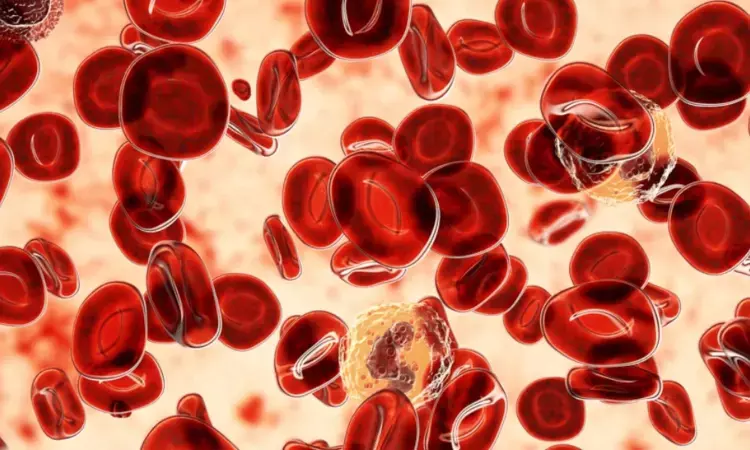- Home
- Medical news & Guidelines
- Anesthesiology
- Cardiology and CTVS
- Critical Care
- Dentistry
- Dermatology
- Diabetes and Endocrinology
- ENT
- Gastroenterology
- Medicine
- Nephrology
- Neurology
- Obstretics-Gynaecology
- Oncology
- Ophthalmology
- Orthopaedics
- Pediatrics-Neonatology
- Psychiatry
- Pulmonology
- Radiology
- Surgery
- Urology
- Laboratory Medicine
- Diet
- Nursing
- Paramedical
- Physiotherapy
- Health news
- Fact Check
- Bone Health Fact Check
- Brain Health Fact Check
- Cancer Related Fact Check
- Child Care Fact Check
- Dental and oral health fact check
- Diabetes and metabolic health fact check
- Diet and Nutrition Fact Check
- Eye and ENT Care Fact Check
- Fitness fact check
- Gut health fact check
- Heart health fact check
- Kidney health fact check
- Medical education fact check
- Men's health fact check
- Respiratory fact check
- Skin and hair care fact check
- Vaccine and Immunization fact check
- Women's health fact check
- AYUSH
- State News
- Andaman and Nicobar Islands
- Andhra Pradesh
- Arunachal Pradesh
- Assam
- Bihar
- Chandigarh
- Chattisgarh
- Dadra and Nagar Haveli
- Daman and Diu
- Delhi
- Goa
- Gujarat
- Haryana
- Himachal Pradesh
- Jammu & Kashmir
- Jharkhand
- Karnataka
- Kerala
- Ladakh
- Lakshadweep
- Madhya Pradesh
- Maharashtra
- Manipur
- Meghalaya
- Mizoram
- Nagaland
- Odisha
- Puducherry
- Punjab
- Rajasthan
- Sikkim
- Tamil Nadu
- Telangana
- Tripura
- Uttar Pradesh
- Uttrakhand
- West Bengal
- Medical Education
- Industry
Ropeg superior to phlebotomy alone in maintaining hematocrit control in polycythemia vera

Italy: Exposure to low-dose ropeginterferon alfa-2b (ropeg) is more effective than the standard treatment of phlebotomy and aspirin in patients with low-risk polycythemia vera (PV), a 24-month trial published in NEJM Evidence has shown.
Treatment with ropeg was superior to phlebotomy alone in maintaining hematocrit on target with reduced need for phlebotomy without thrombotic complications.
Tiziano Barbui and the research team from Italy reported the final results of the phase 2 randomized clinical trial, the Low-PV trial, testing the efficacy and safety profile of ropeg versus a rigorous phlebotomy-only program for treating patients with low-risk PV.
Polycythemia vera is a myeloproliferative neoplasm with characteristics of uncontrolled clonal proliferation of multipotent bone marrow progenitors, sustained mainly by mutations in the JAK2 (Janus tyrosine kinase 2) gene.
Therapy for PV is titrated to keep the hematocrit at or below a target of 45%, a cut point to reduce thrombotic cardiovascular complications. Patients below 60 without prior thrombosis are considered "low risk." For this population, the guideline recommends only phlebotomy and low-dose aspirin. Patients above 60 years with prior thrombosis are considered "high risk". In such patients, cytoreductive drugs are suggested in addition to phlebotomy and aspirin. Whether phlebotomy alone can adequately maintain target hematocrit in patients with low-risk PV remains elusive.
The researchers compared ropeginterferon alfa-2b (100 μg every two weeks) with phlebotomy only concerning the maintenance of a median hematocrit level of ≤45% over 12 months in the absence of progressive disease (primary endpoint). If the primary endpoint was not met, crossover to the alternative treatment group was allowed in the follow-up.
The researchers reported the following findings:
- 127 patients were enrolled (ropeg: n=64; standard group: n=63). The primary endpoint was met in 81% and 51% of the ropeg and standard groups, respectively.
- Responders continued the assigned treatment until month 24 and maintained 83% and 59% responses, respectively.
- Ropeg responders less frequently experienced moderate/severe symptoms (33% versus 67% in the standard group) and palpable splenomegaly (14% versus 37%) and showed normalization of ferritin levels and blood counts.
- Nonresponders at 12 months crossed over to the standard (n=9) or ropeg (n=23) group; in patients switched to ropeg only, 7 of 23 met the response criteria in 12 months, and phlebotomy need was high (4.7 per patient per year).
- Discontinuation because of adverse events occurred in seven patients treated with ropeg.
"Our findings showed ropeg superior to phlebotomy alone in maintaining hematocrit on target," the researchers wrote. "No dose-limiting side effects or toxicities were seen; 9.2% of patients on ropeg and no patients on standard treatment developed neutropenia."
Reference:
The study "Ropeginterferon versus Standard Therapy for Low-Risk Patients with Polycythemia Vera" was published in NEJM Evidence. DOI: 10.1056/EVIDoa2200335
Dr Kamal Kant Kohli-MBBS, DTCD- a chest specialist with more than 30 years of practice and a flair for writing clinical articles, Dr Kamal Kant Kohli joined Medical Dialogues as a Chief Editor of Medical News. Besides writing articles, as an editor, he proofreads and verifies all the medical content published on Medical Dialogues including those coming from journals, studies,medical conferences,guidelines etc. Email: drkohli@medicaldialogues.in. Contact no. 011-43720751


